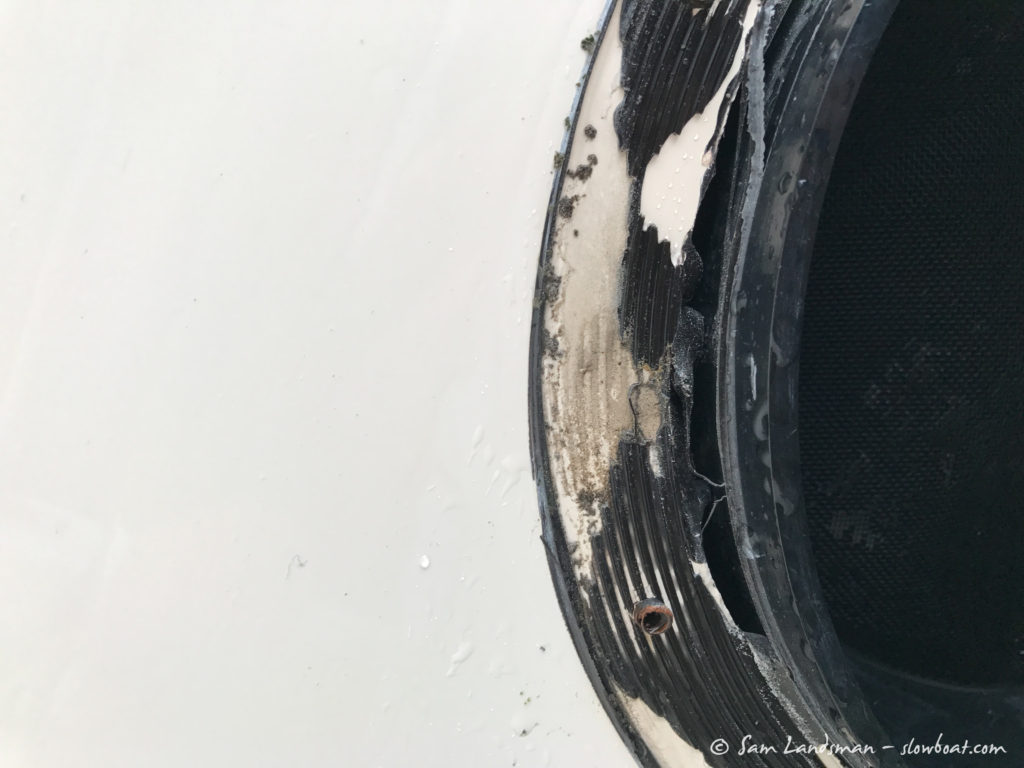Summer 2017 was one for the record books in Southeast Alaska. In a place known for rain, this was the rainiest summer ever. More than 45 inches fell in Ketchikan in June, July, and August. That’s nearly double their average and more rain than typically falls on Seattle in an entire year.
All this rain exposed a few leaks aboard Safe Harbour. At 17-years-old and with more than 5000 hours underway, a few leaks are inevitable. Boats flex and vibrate. Materials heat up and cool down at different rates, expanding and contracting in the process. Sealants fail. Unfortunately leaks seldom seal themselves, typically worsen, and can lead to mold, rotten decks, and worse. Thus, eliminating the very minor leaks on Safe Harbour is a high-priority winter project. I figure that if a few leaks have begun, more are on the way, so this winter I’m going to re-bed everything that penetrates the deck or cabin sides.

Here’s the preliminary list:
- Re-bed all deck hardware (cleats, stanchions, fills, hatches, faux stack, etc.)
- Remove, rebuild, and reinstall all windows. The window frames are painted aluminum and showing their age. They’ll be sandblasted, repainted, have all new gaskets installed, and be reinstalled on the boat.
- Replace plastic portlights with stainless
Eliminating leaks is just one part of my winter project list. Here’s a system-by-system look at what I’m planning. Most of this is routine preventative maintenance, but a few address recent failures.
Main engine:
- Replace exhaust elbow and original wet exhaust hose
- Pull aftercooler, clean, pressure test, reinstall
- Adjust valves
- Pull and test injectors, replace as needed
- Change oil, filter, and fuel filters
- Change transmission oil
- Replace impeller
- Replace throttle and shift cables, leave original cables installed but unattached as emergency backup
Generator:
- Drain coolant, flush cooling system, remove heat exchanger core and have cleaned and pressure tested. Replace thermostat. Replace heat exchanger boots and hose clamps (AWAB hose clamp…MUCH better quality than most)
- Inspect and (probably) replace exhaust elbow
- Find short in 12V electrical system (likely the voltage regulator)
- Change oil, filter, and fuel filters
Steering:
- Small hydraulic leaks visible at autopilot pump and steering ram
- Drain steering fluid
- Remove AP pump and send to Accusteer in Bellingham for rebuild
- Remove steering ram, install new seal kit
- Remove helm (not currently leaking), clean check valves, install new seals
- Fill with fresh hydraulic fluid
Watermaker:
- New seals and oil for high pressure pump
- Paint pump housing
Ground tackle:
- Remove windlass motor, take to motor/alternator shop for inspection and possible rebuild
- Install new control arm (old one is bent)
- Mark chain with fresh zip ties
- Clean anchor locker
Dinghy/davit:
- Replace davit cable with spectra line (can be easily cut for quick escape in case of fire or other emergency, plus no corrosion!)
- Service outboard
- New spark plugs
- Change lower unit oil and seals if necessary
- Change impeller
- Adjust shift linkage to make smoother
- Install new prop

Miscellaneous:
- Replace propane sniffer (failed in August)
- Relocate propane solenoid and regulator higher in locker to avoid get drenched in seawater in rough conditions
- Replace windshield wiper pantograph adapters, arms, and blades (originals are a rusted mess)
- Haul and bottom paint
- Remove prop, tune, reinstall
- Check and replace zincs as necessary
- Wax entire exterior
- Install new WiFi booster (failed in July)
- Install exterior cell phone antenna for booster
- I’m sure there will be more!
This is a BIG list of projects, the biggest in the four years I’ve owned the boat. Much of the work could probably be reduced or eliminated. I could re-bed the existing portlights instead of installing new ones, fix the few window leaks rather than rebuilding all the windows, leave the generator thermostat alone, and keep monitoring the leaks (really weeps, the total volume of leaked fluid in 500 hours is not measurable) in the steering system. But I’m not tolerant of failures. Next summer, I don’t want to find the bed soaked by rain or the steering system inoperable or the generator overheating because I didn’t take care of it during the winter, when parts and expertise are easy to find.
Maintaining a heavily-cruised boat is a time-and-money intensive process to be sure, but the cost of not maintaining all these systems—in downtime, dollars, and frustration—is far higher.
As I chip away at the projects, I’ll share what I’m doing and what I learn. If you have questions, don’t be afraid to ask. And if you have tips or suggestions, please share!
